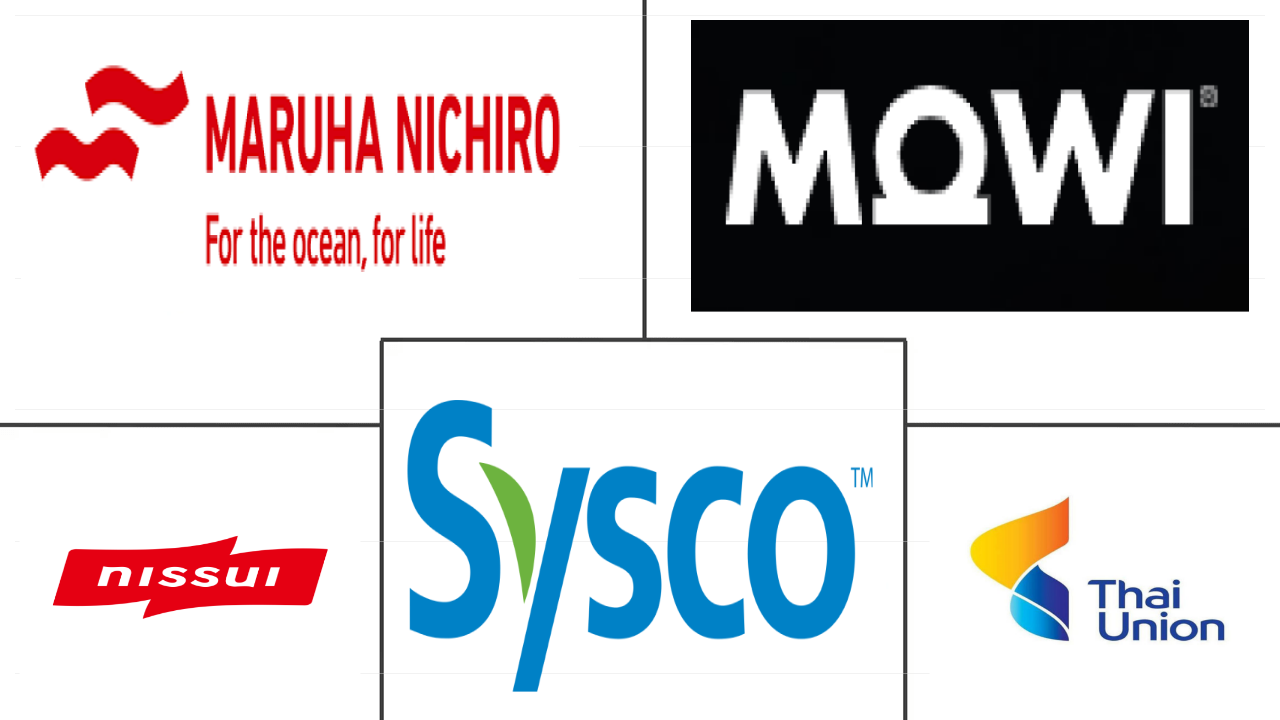Market Size of frozen and canned seafood Industry
| Icons | Lable | Value |
|---|---|---|
|
|
Study Period | 2017 - 2029 |
|
|
Market Size (2024) | USD 468.43 Billion |
|
|
Market Size (2029) | USD 495.15 Billion |
|
|
Largest Share by Type | Fish |
|
|
CAGR (2024 - 2029) | 1.12 % |
|
|
Largest Share by Region | Asia-Pacific |
Major Players |
||

|
||
|
*Disclaimer: Major Players sorted in no particular order |
Frozen and Canned Seafood Market Analysis
The Frozen and Canned Seafood Market size is estimated at 468.43 billion USD in 2024, and is expected to reach 495.15 billion USD by 2029, growing at a CAGR of 1.12% during the forecast period (2024-2029).
468.43 Billion
Market Size in 2024 (USD)
495.15 Billion
Market Size in 2029 (USD)
2.38 %
CAGR (2017-2023)
1.12 %
CAGR (2024-2029)
Largest Segment by Region
71.63 %
value share, Asia-Pacific, 2023
Since most of the countries in the region have long coastal lines, seafood is a major part of many national economies and is also important in their food cultures as well.
Largest Segment by Type
70.57 %
value share, Fish, 2023
The demand for fish is fueled by a range of factors, including fish's lower price, greater nutritional value, and ease of availability due to increased production.
Fastest-growing Segment by Region
2.63 %
Projected CAGR, Africa, 2024-2029
Due to the region's improved cold chain infrastructure and growing awareness of nutritional benefits of seafood, the market is growing at a faster rate.
Fastest-growing Segment by Type
1.16 %
Projected CAGR, Shrimp, 2024-2029
The growth of the aquaculture sector supports the progress of the shrimp market across regions, with farmed shrimp dominating the on-trade and off-trade channels.
Leading Market Player
1.15 %
market share, Maruha Nichiro Corporation, 2022

The company offers a vast range of frozen, and canned seafood products for on-trade as well as off-trade channels. Among all, canned salmon is company's most favored product.
Convenience and portion control are among the major factors propelling the market’s growth
- The global frozen and canned seafood market registered a CAGR of 2.44% from 2017 to 2022, owing to changing lifestyles, rising preference for seafood with growing health consciousness, rising disposable incomes, increased demand for quick meals, and the emergence of private labels. A change in consumers' preferences prompted a shift toward seafood products with a longer shelf life, like canned and frozen products. Canned seafood is growing in popularity and is associated with fairly low levels of food loss and waste. Portion control also takes place while canning since seafood is canned in small servings. Canned fish held the major share in the market, i.e., 70.69% by value in 2022. Canned tuna is the most popular canned fish consumed across the world.
- The frozen seafood marketing landscape in grocery stores has changed significantly due to the introduction of added value and convenience. Frozen fish is the major type of seafood consumed across the world. The overall sales value of frozen fish increased by 12.47% from 2017 to 2022. Retail supermarkets steadily expanded seafood offerings in their freezer cases over the last few years, and more are adding premium frozen seafood cases near fresh seafood counters. Retailers are responding to the changing purchasing behavior of consumers by providing more seafood options.
- Frozen shrimp is the fastest-growing segment, registering an estimated CAGR of 1.18% during the forecast period. Frozen shrimp has become increasingly popular due to the rapid growth of shrimps in the aquaculture industry and the growing awareness of frozen shrimp online.
Extensive fish and shrimp farming lead to extensive investments.
- The overall growth rate of frozen and canned seafood sales increased to 21.5%, by value, from 2017 to 2022. People started consuming frozen and canned seafood and meat products to fulfill their nutrient requirements as prices for fish and shrimp increased by 9% and 6.5%, respectively, from 2017 to 2022. China is heavily dependent on fish and shrimp farming and has made large-scale investments in the sector.
- In 2022, Asia-Pacific dominated frozen and canned seafood consumption with a market share of 47.4% more than Europe, 52.4% more than Africa, 54.4% more than North America, and 57.4% more than South America. This was a result of the rising demand for seafood in countries like India, where imports rose by 180% from 2019 to 2021. Malaysia is one of the biggest seafood consumers, and it saw an increase in frozen/canned fish and seafood imports by 15% from 2019 to 2021. While in South Korea, due to a rise in demand for Korean seafood dishes, frozen or canned seafood imports climbed by 10-15% between 2019 and 2021.
- Out of all the regions, Africa is predicted to be the fastest-growing frozen seafood country, with an anticipated CAGR of 2.65% in value during the forecast period. This is due to the rising personal disposable income in Africa, which increased by 2% to 3% between 2020 and 2021. The regional trend fits in with the continental trend of rising personal incomes brought on by increased urbanization, which further encouraged customer preferences for seafood that is ready to eat. Fish is a significant dietary source in Egypt, making up 25.3% of the typical household's protein consumption. According to estimates, each Egyptian consumes 23.5 kg of fish per year.
